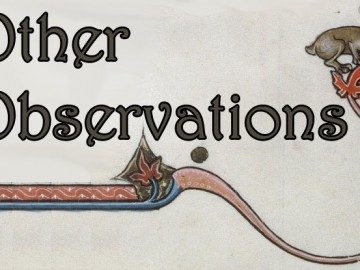by Carol L. Robinson
As I make final preparations for my Spring Semester classes, including a Literature in English I (British literature up to 1800 CE), I find myself reevaluating the advice I give students in researching scholarship and other reliable information on medieval British texts. The question that I have been asking myself is with regard to the quality of Wikipedia as a primary reference of information (as an online encyclopedia). As many have noted, Wikipedia is as much a means for rewriting history, for playing pranks upon colleagues, for generating propaganda and other lies as it is for promoting ideas and facts, for collaborative expressions, and for sharing valuable and reliable sources and materials. However, it is also a means for marginalization via categorization. As James Gleick once noted in an article for The New York Review of Books, “It’s fair to say that Wikipedia has spent far more time considering the philosophical ramifications of categorization than Aristotle and Kant ever did.” Perhaps. 
As of today, there is no page for Medieval British Literature ;there are pages for literature of various centuries (and apparently of various languages). There is a more general page for Medieval Literature that initially acknowledges itself to be covering a “broad subject” before listing such short-content categories (links to other pages) as:
- Languages,
- Anonymity,
- Types of Writing,
- Notable Literature of the Period,
- Specific [Wikipedia] Articles,
- References (of which there are only three listed), and
- External Links (of which there are six listed).
The Languages section is almost absurd in its brevity.
Since Latin was the language of the Roman Catholic Church, which dominated Western and Central Europe, and since the Church was virtually the only source of education, Latin was a common language for medieval writings, even in some parts of Europe that were never Romanized. However, in Eastern Europe, the influence of the Eastern Roman Empire and the Eastern Orthodox Church made Greek and Old Church Slavonic the dominant written languages.
The common people continued to use their respective vernaculars. A few examples, such as the Old EnglishBeowulf, the Middle High GermanNibelungenlied, the Medieval GreekDigenis Acritas, the Old East SlavicTale of Igor’s Campaign, and the Old FrenchChanson de Roland, are well known to this day. Although the extant versions of these epics are generally considered the works of individual (but anonymous) poets, there is no doubt that they are based on their peoples’ older oral traditions. Celtic traditions have survived in the lais of Marie de France, the Mabinogion and the Arthurian cycles.
The other categories are equally limited and even random (such as in the listing of types of writing, notable literature, or references and external links). However, it is not my intention to make cheap shots at how un-scholarly Wikipedia tends to be. That’s just too easy (as I hope I have illustrated, above). For students of medieval studies, Wikipedia can still be a quicksand pool of misinformation and misleading information; yet, for scholars and teachers of medieval studies, it is becoming a great source for facsimiles and quick searches for information already generally known.
For example, even though the page for Cædmon’s Hymn is limited—as is noted at the top by Wikipedia—it does provide a handy image of a manuscript image, as well as a good start for references and even a link to another page devoted to Peter Robinson’s novel, Cædmon’s Song. How fun is that?! Even though there is not a lot to use on this page for Cædmon’s Hymn, the page serves as a reminder that the Internet (as a whole, not just within Wikipedia) provides materials that are far more readily available than ever before. I look more closely at the image of the Cædmon’s Hymn manuscript. The page where
it is stored notes “Image of copy (c800) Cædmon’s Hymn in the “Moore” manuscript (737), Cambridge, Kk.5.16, f. 128v, written in Northumbrian. This is the earliest known version of this work,” and that “This is a faithful photographic reproduction of a two-dimensional, public domain work of art,” which means that I can share it (freely) on this blog, so that we might discuss its meaning.
At the top of the page, Wikipedia provides a boxed statement: “This article needs additional citations for verification. (March 2014),” that invites uses to contribute to the work.

